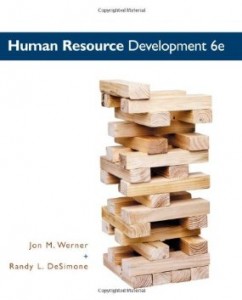Test Bank for Human Resource Development, 6th Edition : Werner

Product details:
- ISBN-10 : 9780538480994
- ISBN-13 : 978-0538480994
- Author: Werner
Master the basics of human resource development with HUMAN RESOURCE DEVELOPMENT! Providing you with a clear understanding of the concepts, processes, and practices that form the basis of success, this management text shows you how concepts and theory can be put into practice in a variety of organizations. Coverage includes strategic issues in HRD, employee behavior, implementing HRD programs, training, research and statistics, and team-based coverage.
Table contents:
- Part 1: Foundations of Human Resource Development
- Ch 1: Introduction to Human Resource Development
- Introduction
- The Progression toward a Field of Human Resource Development
- The Relationship between Human Resource Management and HRD/Training
- Human Resource Development Functions
- Roles and Competencies of an HRD Professional
- Challenges to Organizations and to HRD Professionals
- A Framework for the HRD Process
- Organization of the Text
- Ch 2: Influences on Employee Behavior
- Introduction
- Model of Employee Behavior
- External Influences on Employee Behavior
- Motivation: A Fundamental Internal Influence on Employee Behavior
- Other Internal Factors that Influence Employee Behavior
- Ch 3: Learning and HRD
- Introduction
- Learning and Instruction
- Maximizing Learning
- Individual Differences in the Learning Process
- Learning Strategies and Styles
- Further Contributions from Instructional and Cognitive Psychology
- Part 2: Framework for Human Resource Development
- Ch 4: Assessing HRD Needs
- Introduction
- Strategic/Organizational Analysis
- Task Analysis
- Person Analysis
- Prioritizing HRD Needs
- The HRD Process Model Debate
- Ch 5: Designing Effective HRD Programs
- Introduction
- Defining the Objectives of the HRD Intervention
- The “Make-Versus-Buy” Decision: Creating or Purchasing HRD Programs
- Selecting the Trainer
- Selecting Training Methods and Media
- Preparing Training Materials
- Scheduling an HRD Program
- Ch 6: Implementing HRD Programs
- Introduction
- Training Delivery Methods
- On-The-Job Training (OJT) Methods
- Classroom Training Approaches
- The Lecture Approach
- The Discussion Method
- Audiovisual Media
- Computer-Based Training (Classroom-Based)
- Self-Paced/Computer-Based Training Media and Methods
- Some Final Issues Concerning Training Program Implementation
- Arranging the Physical Environment
- Getting Started
- Ch 7: Evaluating HRD Programs
- Introduction
- The Purpose of HRD Evaluation
- How often are HRD Programs Evaluated?
- The Evaluation of Training and HRD Programs Prior to Purchase
- Changing Evaluation Emphases
- Models and Frameworks of Evaluation
- Kirkpatrick’s Evaluation Framework
- Other Frameworks or Models of Evaluation
- Comparing Evaluation Frameworks
- A Stakeholder Approach to Training Evaluation
- Data Collection for HRD Evaluation
- Data Collection Methods
- Choosing Data Collection Methods
- Types of Data
- The Use of Self-Report Data
- Research Design
- Ethical Issues Concerning Evaluation Research
- Assessing the Impact of HRD Programs in Monetary Terms
- How Technology Impacts HRD Evaluation
- Closing Comments on HRD Evaluation
- Appendix 7-1 More on Research Design
- Research Design Validity
- Nonexperimental Designs
- Experimental Designs
- Quasi-Experimental Designs
- Statistical Power: Ensuring that a Change will be Detected if One Exists
- Selecting a Research Design
- Part 3: Human Resource Development Applications
- Ch 8: Onboarding: Employee Socialization and Orientation
- Introduction
- Socialization: The Process of Becoming an Insider
- Various Perspectives on the Socialization Process
- The Realistic Job Preview
- Ch 9: Skills and Technical Training
- Introduction
- Basic Workplace Competencies
- Basic Skills/Literacy Programs
- Technical Training
- Interpersonal Skills Training
- Role of Labor Unions in Skills and Technical Training Programs
- Professional Development and Education
- Ch 10: Coaching and Performance Management
- Introduction
- The Need for Coaching
- Coaching: A Positive Approach to Managing Performance
- Coaching and Performance Management
- Definition of Coaching
- Role of the Supervisor and Manager in Coaching
- The HRD Professional’s Role in Coaching
- Coaching to Improve Poor Performance
- Defining Poor Performance
- Responding to Poor Performance
- Conducting the Coaching Analysis
- Maintaining Effective Performance and Encouraging Superior Performance
- Skills Necessary for Effective Coaching
- The Effectiveness of Coaching
- Employee Participation in Discussion
- Being Supportive
- Using Constructive Criticism
- Setting Performance Goals during Discussion
- Training and the Supervisor’s Credibility
- Organizational Support
- Closing Comments on Coaching and Performance Management
- Ch 11: Employee Counseling and Wellness Services
- Introduction
- An Overview of Employee Counseling Programs
- Employee Assistance Programs
- Stress Management Interventions
- Employee Wellness and Health Promotion Programs
- Exercise and Fitness Interventions
- Smoking Cessation
- Issues in Employee Counseling
- Closing Comments
- Ch 12: Career Management and Development
- Introduction
- Defining Career Concepts
- Stages of Life and Career Development
- Models of Career Development
- The Process of Career Management
- Roles in Career Management
- Career Development Practices and Activities
- Issues in Career Development
- Delivering Effective Career Development Systems
- Ch 13: Management Development
- Introduction
- Describing the Manager’s Job: Management Roles and Competencies
- Making Management Development Strategic
- Management Education
- Bachelor’s or Master’s Degree Programs in Business Administration
- Executive Education Programs
- Management Training and Experiences
- Examples of Approaches Used to Develop Managers
- Designing Effective Management Development Programs
- Ch 14: Organization Development and Change
- Introduction
- Organization Development Theories and Concepts
- Model of Planned Change
- Designing an Intervention Strategy
- Types of Interventions: Human Process-Based
- Types of Interventions: Techno-Structural
- Types of Interventions: Sociotechnical Systems
- Types of Interventions: Organizational Transformation
- Whither Organization Development?
- Ch 15: HRD and Diversity: Diversity Training and Beyond
- Introduction
- Organizational Culture
- Labor-Market Changes and Discrimination
- Adapting to Demographic Changes
- Cross-Cultural Education and Training Programs
- Human Resource Development Programs for Culturally Diverse Employees
- Other Human Resource Management Programs and Processes
- Closing Comments
- Glossary
- Name Index
- Subject Index
- Endnotes
People also search:





